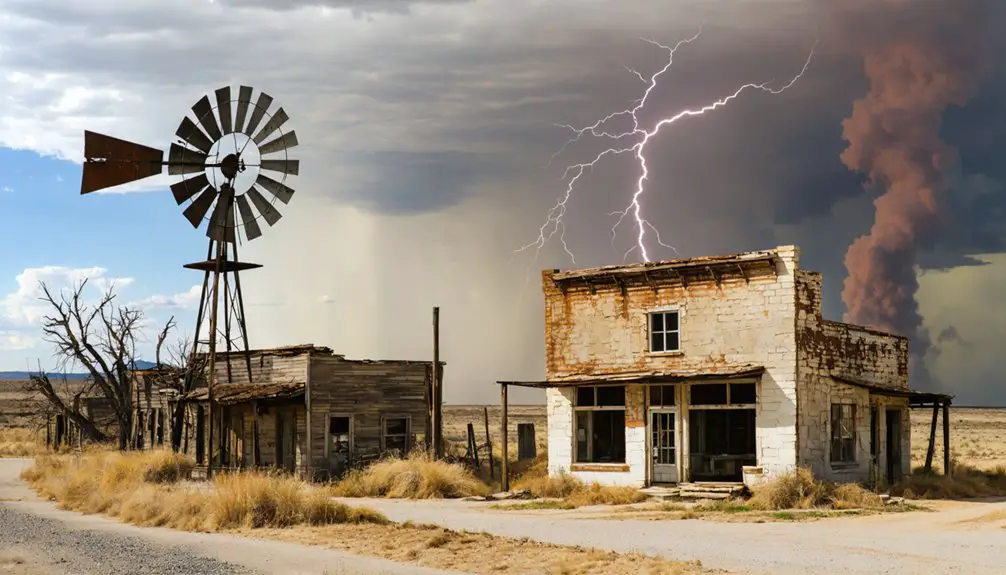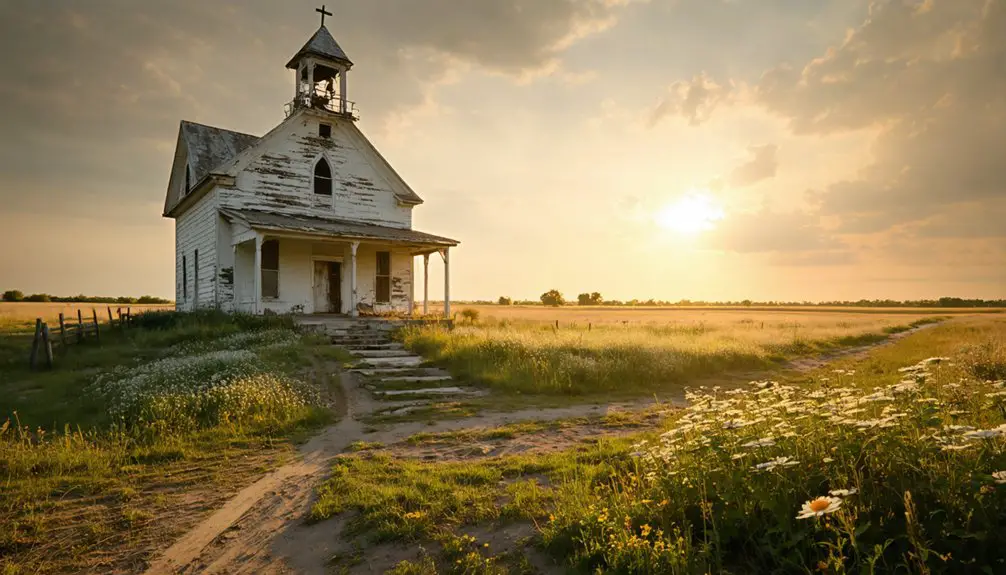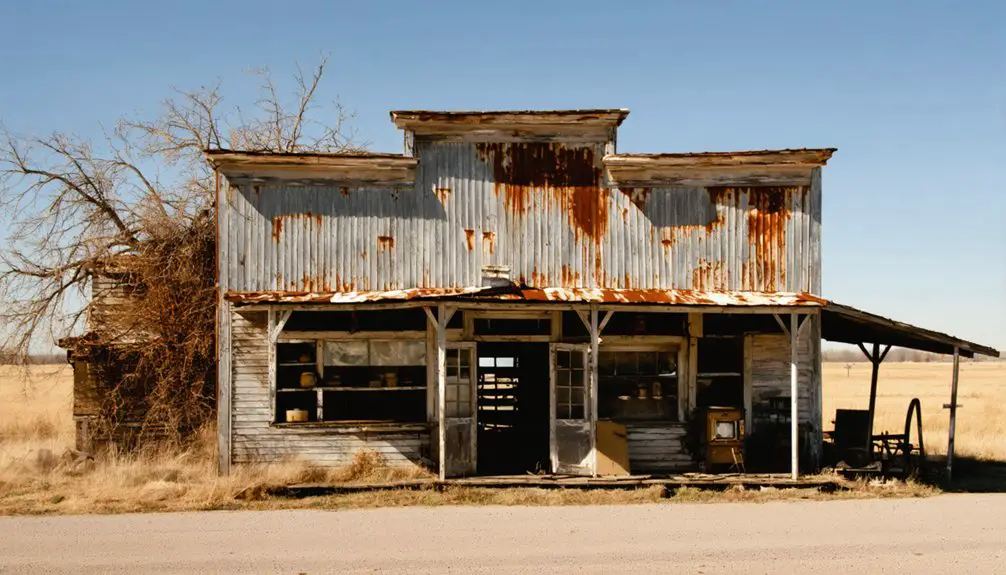You’ll find Burke City‘s remains along Oklahoma’s North Canadian River in Okfuskee County, where Chickasaw Nation members Tom and Wally McGee partnered with John Burke to establish a trading post in 1901. Their general store served as the settlement’s commercial hub, but devastating floods in 1903 forced complete abandonment within two years. While no physical structures remain today, Burke City’s brief existence reveals fascinating insights into Oklahoma’s frontier development and ghost town legacy.
Key Takeaways
- Burke City was founded in 1901 by Chickasaw Nation members and John Burke as a trading post along Oklahoma’s North Canadian River.
- The town’s primary business was a general store established through the McGee-Burke partnership, serving the emerging frontier settlement.
- Devastating floods struck Burke City around 1903, leading to complete abandonment within two years of its founding.
- No physical structures remain at the Burke City site today, with the area reverting to natural riverbank terrain.
- Burke City represents one of Oklahoma’s 2,000+ ghost towns, demonstrating the impact of natural disasters on frontier settlements.
The Brief Rise of Burke City
Located on the south bank of the North Canadian River in Okfuskee County, Oklahoma, Burke City emerged in 1901 through the entrepreneurial vision of Chickasaw Nation members Tom and Wally McGee, who partnered with John Burke.
The town dynamics centered around their general store, which served as the primary commercial hub just two miles east of Bearden.
You’ll find that Burke City’s settlement patterns reflected the era’s frontier spirit, with the founders strategically choosing the riverside location to capitalize on trade and transportation opportunities.
The partnership between Native American businessmen and settlers demonstrated the collaborative nature of territorial development.
While the town aimed to become a thriving commercial center for the local area, its brief existence would ultimately span just two years before nature intervened.
Like many ghost town settlements across Oklahoma, Burke City’s development was characteristic of the thousands of similar communities that emerged and vanished during the territorial period.
The town’s ultimate demise came when severe flooding of the North Canadian River forced residents to abandon their homes and businesses.
The McGee-Burke Partnership
The McGee-Burke Partnership, founded in 1901 by Chickasaw Nation members Tom and Wally McGee alongside John Burke, established Burke City’s first general store on the south bank of the North Canadian River.
You’ll find their business strategy focused on serving the emerging settlement’s needs while capitalizing on the river’s transportation advantages.
Though the partnership lasted only until 1903, their collaborative effort between Native American entrepreneurs and local settlers exemplified the dynamic commercial relationships forming in early Oklahoma Territory. The area would later become home to Anderson & Kerr Drilling, founded in July 1929 as the region’s oil industry began to flourish.
The company evolved significantly over the years, becoming Kerr-McGee Corporation in 1946 and establishing itself as a major player in oil and gas production.
Business Formation Details
During the frontier development of Oklahoma Territory in 1901, three enterprising individuals – Tom McGee, Wally McGee, and John Burke – formed a pivotal business partnership that would shape Burke City’s brief but significant existence.
The quantum meruit principle established in later Oklahoma courts would prove influential in resolving business partnership disputes like these.
Their partnership dynamics reflected a groundbreaking collaboration between Native American entrepreneurs from the Chickasaw Nation and settler interests. Similar to Robert L. Owen, their business ventures bridged cultural and territorial divides.
You’ll find that their first joint venture centered on a general store, strategically positioned two miles east of Bearden along the North Canadian River‘s south bank. This entrepreneurial collaboration established a commercial hub that served the surrounding population, capitalizing on the river’s transportation advantages.
They’d structured their business following territorial legal frameworks, creating a formalized agreement that would later prove essential when they relocated their enterprise to Okemah and founded the Creek Trading Company.
Town Investment Strategy
Strategic investment decisions shaped Burke City’s development under the McGee-Burke partnership, reflecting both the opportunities and risks of frontier commerce in 1901.
You’ll find their primary investment centered on establishing a general store two miles east of Bearden, positioned along the North Canadian River‘s south bank to capitalize on water transport and regional trade.
Much like Blake Burke’s scouting, their strategy carried significant investment risks, requiring patience and careful assessment before yielding potential long-term rewards.
While they’d successfully created a hub for community commerce, serving both agricultural and indigenous trade, their strategy carried significant investment risks.
The partners didn’t invest in flood prevention despite the riverside location, and they’d focused heavily on a single-business model without diversification.
This lack of environmental risk management proved fatal when flooding destroyed the town in 1903, ending their venture after just two years of operation.
Partnership Impact Assessment
Pioneering a unique collaboration in early Oklahoma commerce, the McGee-Burke partnership established a significant footprint through its convergence of Native American influence and entrepreneurial vision.
You’ll find their partnership dynamics reflected in the strategic placement of their general store along the North Canadian River, which served as a crucial commercial hub for the region’s settlers and travelers.
The partnership’s economic resilience was tested through their two-year operation, demonstrating remarkable adaptability in frontier conditions.
While their venture showed promise in developing Burke City’s infrastructure and facilitating regional trade, nature ultimately proved insurmountable.
The devastating flood of 1903 not only destroyed their physical investments but also ended this groundbreaking collaboration between the Chickasaw McGee brothers and John Burke, leaving behind a legacy of pioneering spirit in Oklahoma’s territorial commerce.
Life Along the North Canadian River
Life along the North Canadian River shaped the destinies of both Native Americans and European settlers, as its waters carved an essential lifeline through Oklahoma’s diverse terrain.
The North Canadian River served as nature’s highway, weaving together the fates of indigenous peoples and settlers across Oklahoma’s landscape.
You’d find rich river ecosystems stretching from semi-desert lands to lush forests, supporting indigenous traditions that thrived for generations. The Chickasaw, Spiro, Wichita, and other tribes mastered these waters, developing sophisticated systems for hunting, trading, and farming that adapted to the river’s seasonal rhythms.
When European explorers arrived in the 1600s, they discovered well-established Native communities who’d learned to navigate the river’s challenging quicksands and intermittent flows. The Chickasaw settlers from Mississippi established strong communities along these waterways, eventually gaining their own form of government through the 1855 treaty. The French traders built trading posts that became vital economic hubs for commerce between indigenous peoples and European settlers.
As French traders established routes and Spanish expeditions sought riches, the river became a significant corridor for commerce. These waters would later witness dramatic changes as railroads emerged and the 1889 Land Run transformed the region’s social fabric forever.
Natural Forces and Town Destruction

While Native Americans and early settlers learned to harness the North Canadian River’s benefits, its destructive power would ultimately seal Burke City’s fate.
Similar to how Ralph G. Warner worked in harsh mining conditions, you’ll find that the town’s location along the river’s south bank made it especially vulnerable to the flood dynamics that would soon unfold. Without modern flood control infrastructure, the settlement stood defenseless against the river’s seasonal swells and natural river meanders that shaped the surrounding floodplain.
When devastating floods struck around 1903, you can imagine how quickly the town’s buildings and hopes washed away.
Unlike other ghost towns that gradually faded due to economic factors, Burke City’s end came swiftly and decisively. Within just two years of its founding, the floodwaters forced a complete abandonment, leaving no trace of the young settlement’s brief existence.
Oklahoma’s Ghost Town Legacy
Throughout Oklahoma’s diverse landscape, you’ll discover over 2,000 ghost towns that tell compelling stories of boom-and-bust cycles, natural disasters, and shifting economic fortunes.
These abandoned settlements trace their ghost town origins to various sources: liquor towns that flourished before statehood, boomtowns that emerged during oil rushes, and communities that formed around mining operations and railroad stops.
You can witness the impact of economic decline across the state, from Pushmataha County’s 13 ghost towns to the toxic remains of Picher.
These forgotten places reflect Oklahoma’s complex history, where Native American settlements, government projects, and transportation routes shaped community destinies.
Whether it’s Texola’s disputed state lines or Kenton’s unique Mountain Time observance, each ghost town preserves a distinct chapter of Oklahoma’s frontier spirit.
Historical Impact on Okfuskee County

In 1901, Tom and Wally McGee partnered with John Burke to establish an essential trading post on the south bank of the North Canadian River in what would become Burke City.
The settlement dynamics of this venture showcased the potential for cultural exchange between Chickasaw Nation members and frontier settlers through shared commerce and trade relationships.
You’ll find that Burke City’s brief existence profoundly shaped Okfuskee County’s development patterns.
After the devastating flood of 1903 destroyed the settlement, future town planners learned valuable lessons about environmental risks, leading them to choose safer locations for new communities.
The 1903 flood that destroyed Burke City became a cautionary tale, guiding Oklahoma planners toward safer ground for future settlements.
While the town’s physical presence lasted only two years, its impact on local history endures as a reflection of both the challenges and opportunities that marked Oklahoma’s frontier development.
The Lost Settlement Today
You won’t find any remaining structures at Burke City’s original location, as the North Canadian River’s flooding completely destroyed the settlement shortly after 1903.
The site, located two miles east of present-day Bearden, has returned to its natural state with no marked paths or historical markers to guide visitors.
What was once a bustling town center with a general store along the riverbank is now classified as a barren ghost town site, making it challenging for history enthusiasts to connect with this piece of Oklahoma’s past.
Physical Remnants Today
Today’s visitors to Burke City, Oklahoma will find no physical remnants of the once-hopeful settlement, as flooding from the North Canadian River completely destroyed the short-lived town.
The site’s archaeological prospects are minimal, with no visible foundations, structures, or ruins remaining from its brief 1901-1903 existence. Natural environmental recovery has transformed the location into typical riverbank terrain, with floodplain features and vegetation obscuring any traces of human habitation.
You’ll encounter only open fields or wild growth where buildings once stood, as the catastrophic flooding washed away or buried all structural evidence.
Modern satellite imagery reveals no urban footprint, and the surrounding landscape has fully reverted to its natural state. The town’s physical legacy exists solely in historical records rather than tangible remains.
Historical Site Access
Reaching the former Burke City site presents significant challenges for modern visitors, as the ghost town’s location lies on a mix of private and public lands near the south bank of the North Canadian River.
If you’re planning site visitation, you’ll need to navigate several access challenges including private property restrictions and unpredictable terrain conditions.
Key considerations for accessing the historical location:
- You’ll need to seek proper permissions, as much of the surrounding area is privately owned.
- The original townsite remains submerged or altered due to the 1903 flooding, with no maintained paths.
- You must rely on county roads to approach the general area, though they don’t lead directly to the site.
Modern exploration requires careful planning, respect for property boundaries, and awareness that no public facilities or historical markers exist to guide your visit.
Frequently Asked Questions
Were There Any Notable Industries Besides the General Store in Burke City?
You won’t find any evidence of mining operations or agricultural activities beyond the general store – historical records show no other industries during Burke City’s brief two-year existence before flooding destroyed it.
What Happened to the Original Founders After the Town Was Destroyed?
You’ll find the founder fates largely undocumented, though most scattered to nearby Oklahoma towns after flooding. They’d lost their investments and community, leaving minimal town legacy beyond scattered oral histories.
How Many Residents Lived in Burke City During Its Peak?
You’ll find no exact population records exist, but given historical patterns of population growth in early 1900s Oklahoma towns, Burke City likely peaked at 200-300 residents before flooding destroyed it.
Did Any Artifacts or Structures Survive the Flooding of Burke City?
You won’t find any surviving artifacts or structures, as the North Canadian River’s devastating flood impact left no trace of Burke City. Records show zero artifact preservation from this sudden destruction.
Were There Any Known Native American Settlements at the Site Before?
Gazing across the empty plains where warriors once roamed, you’d find no documented Native American settlements at this exact site, though the broader region was part of indigenous peoples’ ancestral territories.
References
- https://en.wikipedia.org/wiki/Burke_City
- https://en.wikipedia.org/wiki/List_of_ghost_towns_in_Oklahoma
- https://www.okhistory.org/publications/enc/entry?entry=GH002
- https://northwestprimetime.com/news/2023/may/12/haunting-burke/
- https://kids.kiddle.co/List_of_ghost_towns_in_Oklahoma
- http://www.ou.edu/news/articles/2024/may/ou-researcher-unveils-book-of-oklahomas-ghost-towns.html
- https://www.encyclopedia.com/social-sciences-and-law/economics-business-and-labor/businesses-and-occupations/kerr-mcgee-corp
- https://www.fundinguniverse.com/company-histories/kerr-mcgee-corporation-history/
- https://en.wikipedia.org/wiki/Kerr-McGee
- https://www.oklahomahof.com/programs/publishing/books



